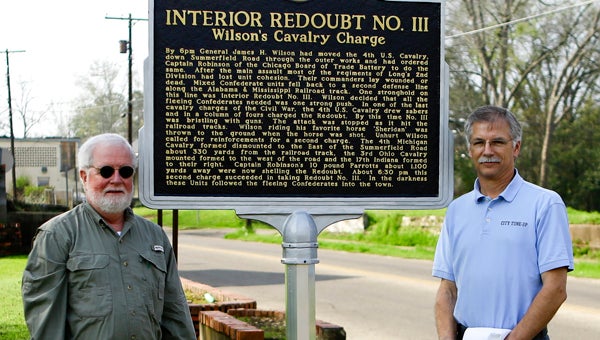Sixth Civil War marker installed
Published 7:45 pm Saturday, March 21, 2015

Buddy Swift, a member of the April 1865 Society, and Benny Austin, vice president of the April 1865 Society, pose for a picture after unveiling the sixth Battle of Selma historic marker on Summerfield Road near the old Alabama and Mississippi railroad tracks.
The 150th anniversary of the Battle of Selma is quickly approaching, and the April 1865 Society, Inc. unveiled its sixth Battle of Selma historic marker Thursday.
The marker, which sits near the old Alabama & Mississippi railroad track on Summerfield Road, tells the story of the fourth U.S. Cavalry’s charge that was led by General Wilson against Interior Redoubt No. III, one of the city of Selma’s first lines of defense.
“They came in a column of fours with their sabers drawn, thinking that they needed just a small push to scatter [Confederate troops,]” James Hammonds, president of the April 1865 Society, said. “They hit that railroad track, and they obviously couldn’t get to [Redoubt III] because of the ditch and railroad track, so they turned with their sabers still in hand and rode almost the entire length of the fortification with Confederate soldiers shooting at them the entire time.”
According to Hammonds, the cavalry’s first charge was a test to see if there was any artillery left in the fort.
“It is one of the last cavalry charges of the Civil War, and I’m pretty sure the last charge that included a Union major general,” Hammonds said.
A second charge that consisted of cavalries from Michigan, Ohio and Indiana took place after the first, which led to the Confederate soldiers fleeing into town.
“There is a famous painting of Wilson charging over the fortification,” Hammonds said. “What they don’t tell you is that Wilson got shot off of his horse. When the second charge occurred, as far as I can tell, Wilson didn’t participate in it, nor did the fourth U.S. Cavalry.”
The charge led to the city’s takeover by Union forces. Once inside the city, Wilson ordered troops to destroy everything that would benefit the Confederacy.
“A Federal trooper said it was one of the most glorious and grand charges he had ever seen in the way that they did it,” Benny Austin, April 1865 Society vice president, said.




